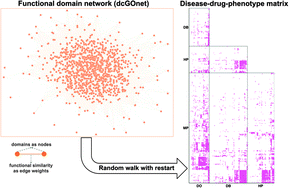A disease-drug-phenotype matrix inferred by walking on a functional domain network†
Abstract

- This article is part of the themed collection: Molecular BioSystems Network Biology
* Corresponding authors
a
Department of Computer Science, University of Bristol, The Merchant Venturers Building, Bristol BS8 1UB, UK
E-mail:
hfang@cs.bris.ac.uk, gough@cs.bris.ac.uk

 Please wait while we load your content...
Something went wrong. Try again?
Please wait while we load your content...
Something went wrong. Try again?
H. Fang and J. Gough, Mol. BioSyst., 2013, 9, 1686 DOI: 10.1039/C3MB25495J
To request permission to reproduce material from this article, please go to the Copyright Clearance Center request page.
If you are an author contributing to an RSC publication, you do not need to request permission provided correct acknowledgement is given.
If you are the author of this article, you do not need to request permission to reproduce figures and diagrams provided correct acknowledgement is given. If you want to reproduce the whole article in a third-party publication (excluding your thesis/dissertation for which permission is not required) please go to the Copyright Clearance Center request page.
Read more about how to correctly acknowledge RSC content.
 Fetching data from CrossRef.
Fetching data from CrossRef.
This may take some time to load.
Loading related content
